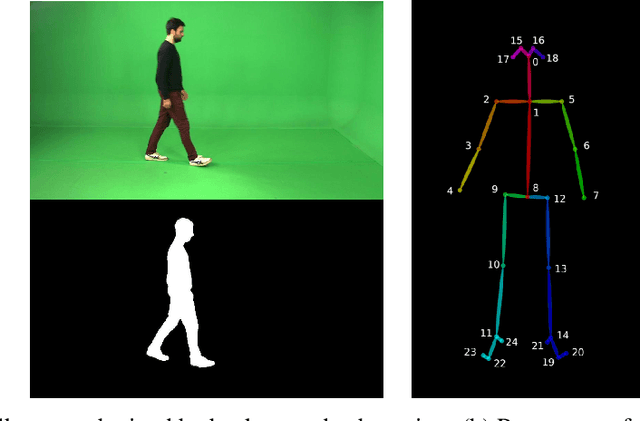Tanmay Tulsidas Verlekar
XAI-based gait analysis of patients walking with Knee-Ankle-Foot orthosis using video cameras
Feb 25, 2024Abstract:Recent technological advancements in artificial intelligence and computer vision have enabled gait analysis on portable devices such as cell phones. However, most state-of-the-art vision-based systems still impose numerous constraints for capturing a patient's video, such as using a static camera and maintaining a specific distance from it. While these constraints are manageable under professional observation, they pose challenges in home settings. Another issue with most vision-based systems is their output, typically a classification label and confidence value, whose reliability is often questioned by medical professionals. This paper addresses these challenges by presenting a novel system for gait analysis robust to camera movements and providing explanations for its output. The study utilizes a dataset comprising videos of subjects wearing two types of Knee Ankle Foot Orthosis (KAFO), namely "Locked Knee" and "Semi-flexion," for mobility, along with metadata and ground truth for explanations. The ground truth highlights the statistical significance of seven features captured using motion capture systems to differentiate between the two gaits. To address camera movement challenges, the proposed system employs super-resolution and pose estimation during pre-processing. It then identifies the seven features - Stride Length, Step Length and Duration of single support of orthotic and non-orthotic leg, Cadence, and Speed - using the skeletal output of pose estimation. These features train a multi-layer perceptron, with its output explained by highlighting the features' contribution to classification. While most state-of-the-art systems struggle with processing the video or training on the proposed dataset, our system achieves an average accuracy of 94%. The model's explainability is validated using ground truth and can be considered reliable.
IKD+: Reliable Low Complexity Deep Models For Retinopathy Classification
Mar 04, 2023Abstract:Deep neural network (DNN) models for retinopathy have estimated predictive accuracies in the mid-to-high 90%. However, the following aspects remain unaddressed: State-of-the-art models are complex and require substantial computational infrastructure to train and deploy; The reliability of predictions can vary widely. In this paper, we focus on these aspects and propose a form of iterative knowledge distillation(IKD), called IKD+ that incorporates a tradeoff between size, accuracy and reliability. We investigate the functioning of IKD+ using two widely used techniques for estimating model calibration (Platt-scaling and temperature-scaling), using the best-performing model available, which is an ensemble of EfficientNets with approximately 100M parameters. We demonstrate that IKD+ equipped with temperature-scaling results in models that show up to approximately 500-fold decreases in the number of parameters than the original ensemble without a significant loss in accuracy. In addition, calibration scores (reliability) for the IKD+ models are as good as or better than the base mode
Domain-Specific Pretraining Improves Confidence in Whole Slide Image Classification
Feb 20, 2023Abstract:Whole Slide Images (WSIs) or histopathology images are used in digital pathology. WSIs pose great challenges to deep learning models for clinical diagnosis, owing to their size and lack of pixel-level annotations. With the recent advancements in computational pathology, newer multiple-instance learning-based models have been proposed. Multiple-instance learning for WSIs necessitates creating patches and uses the encoding of these patches for diagnosis. These models use generic pre-trained models (ResNet-50 pre-trained on ImageNet) for patch encoding. The recently proposed KimiaNet, a DenseNet121 model pre-trained on TCGA slides, is a domain-specific pre-trained model. This paper shows the effect of domain-specific pre-training on WSI classification. To investigate the impact of domain-specific pre-training, we considered the current state-of-the-art multiple-instance learning models, 1) CLAM, an attention-based model, and 2) TransMIL, a self-attention-based model, and evaluated the models' confidence and predictive performance in detecting primary brain tumors - gliomas. Domain-specific pre-training improves the confidence of the models and also achieves a new state-of-the-art performance of WSI-based glioma subtype classification, showing a high clinical applicability in assisting glioma diagnosis.
Remote Pathological Gait Classification System
May 04, 2021



Abstract:Several pathologies can alter the way people walk, i.e. their gait. Gait analysis can therefore be used to detect impairments and help diagnose illnesses and assess patient recovery. Using vision-based systems, diagnoses could be done at home or in a clinic, with the needed computation being done remotely. State-of-the-art vision-based gait analysis systems use deep learning, requiring large datasets for training. However, to our best knowledge, the biggest publicly available pathological gait dataset contains only 10 subjects, simulating 4 gait pathologies. This paper presents a new dataset called GAIT-IT, captured from 21 subjects simulating 4 gait pathologies, with 2 severity levels, besides normal gait, being considerably larger than publicly available gait pathology datasets, allowing to train a deep learning model for gait pathology classification. Moreover, it was recorded in a professional studio, making it possible to obtain nearly perfect silhouettes, free of segmentation errors. Recognizing the importance of remote healthcare, this paper proposes a prototype of a web application allowing to upload a walking person's video, possibly acquired using a smartphone camera, and execute a web service that classifies the person's gait as normal or across different pathologies. The web application has a user friendly interface and could be used by healthcare professionals or other end users. An automatic gait analysis system is also developed and integrated with the web application for pathology classification. Compared to state-of-the-art solutions, it achieves a drastic reduction in the number of model parameters, which means significantly lower memory requirements, as well as lower training and execution times. Classification accuracy is on par with the state-of-the-art.
 Add to Chrome
Add to Chrome Add to Firefox
Add to Firefox Add to Edge
Add to Edge